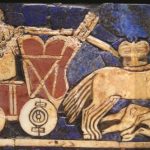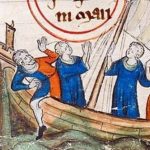 Music
Music  Music
Music  History
History 10 Less Than Jolly Events That Occurred on December 25
 Weird Stuff
Weird Stuff 10 Funny Ways That Researchers Overthink Christmas
 Politics
Politics 10 Political Scandals That Sent Crowds Into the Streets
 Weird Stuff
Weird Stuff Ten Bizarre Facts About The Doge Meme
 Our World
Our World 10 Ways Your Christmas Tree Is More Lit Than You Think
 Movies and TV
Movies and TV The 10 Coolest Stars to Set Sail on The Love Boat
 History
History 10 Things You Didn’t Know About the American National Anthem
 Technology
Technology Top 10 Everyday Tech Buzzwords That Hide a Darker Past
 Humans
Humans 10 Everyday Human Behaviors That Are Actually Survival Instincts
 Music
Music 10 Surprising Origin Stories of Your Favorite Holiday Songs
 History
History 10 Less Than Jolly Events That Occurred on December 25
 Weird Stuff
Weird Stuff 10 Funny Ways That Researchers Overthink Christmas
Who's Behind Listverse?

Jamie Frater
Head Editor
Jamie founded Listverse due to an insatiable desire to share fascinating, obscure, and bizarre facts. He has been a guest speaker on numerous national radio and television stations and is a five time published author.
More About Us Politics
Politics 10 Political Scandals That Sent Crowds Into the Streets
 Weird Stuff
Weird Stuff Ten Bizarre Facts About The Doge Meme
 Our World
Our World 10 Ways Your Christmas Tree Is More Lit Than You Think
 Movies and TV
Movies and TV The 10 Coolest Stars to Set Sail on The Love Boat
 History
History 10 Things You Didn’t Know About the American National Anthem
 Technology
Technology Top 10 Everyday Tech Buzzwords That Hide a Darker Past
 Humans
Humans 10 Everyday Human Behaviors That Are Actually Survival Instincts
10 Shocking Facts about the Short Life of Percy Bysshe Shelley
Percy Bysshe Shelley (1792–1822) is perhaps best known to the wider world today for his marriage to “Frankenstein” author Mary Shelley or as one of the great romantic poets of the English language. But he was both of these things and more.
No stranger to a scandal, Shelley was a political radical and a publisher of provocative pamphlets. He was interested in the occult, but he was also a deep philosophical thinker who kept company with some of the most famous literary names of his day. Shelley fit more into his tragically short lifespan than most people could in a much longer lifetime. Here are ten of the most bizarre and shocking facts about the life of Percy Bysshe Shelley.
Related: 10 Rebel Poets Who Were Totally Badass
10 Obsessed with the Occult and Haunted by Hallucinations
Shelley was born into a wealthy and powerful family. His father was a baronet, and as the eldest son, Shelley was expected to inherit his father’s large estate and seat in the British Houses of Parliament. As a young child, he was already imaginative and playful. This earned him the affection of his five siblings, with whom he would invent games to play. He also entertained them by telling ghost stories, but his interest in spooky and strange things went much further than storytelling.
Despite his young age, Shelley went out walking at night and would have his sisters dress up in fiendish costumes to participate in rituals around a fire. Among his many antics as a student at Eton College, which included electrically shocking a master and blowing up a tree, he was found one night surrounded by blue flames and trying to summon the devil. Shelley later became convinced that the devil was following him while he was out on one of his late-night walks. Hallucinations of figures following him would continue to haunt him for the rest of his life.[1]
9 Crazy Daily Routine and Hardly Slept
After Eton, Shelley went on to Oxford University. There, he had a crazy daily routine. He would reportedly read for as many as sixteen hours each day. His friend Thomas Jefferson Hogg described how Shelley could be found reading at all hours and in all places, even while walking down the bustling streets of London. He read a lot about science and philosophy, and he kept trying to expand his knowledge in these areas, whether or not they were related to the academic work the university required.
However, his day did not end after 16 hours of reading. It is claimed that Shelley only slept for half an hour each night, and he used the rest of the time to perform experiments. This resulted in his room looking like “primeval chaos,” according to Hogg. It had burn marks on many surfaces. Scientific equipment, books, Shelley’s clothes, and even pistols were strewn about the place. The staff tasked with tidying it received no thanks for their futile efforts. Shelley even gave one of their children an electric shock.[2]
8 Expelled from Oxford University for Atheism
Oxford University should have been an ideal place for someone like Shelley, who possessed—as the writer William Michael Rossetti put it—”white-hot intellectual passion.” However, despite minimal academic requirements, he did not even last one year at the university. He basically had to see his tutor once a term, translate an article into Latin each week, and attend chapel every day. An outspoken atheist, he struggled with the latter, and this belief—or rather the lack of it—finally got him expelled.
Shelley and Hogg collaborated during their Christmas break on a provocative pamphlet called “The Necessity of Atheism.” A local bookshop agreed to sell it, but this did not satisfy Shelley, who posted it to all the college heads. At the time, these were all clergymen. He even posted it to several bishops. The pamphlet did not name its authors, but their identities were common knowledge, and Shelley was soon summoned before university officials. He refused to confirm that he was the author and to disavow the work, so they expelled him. Shelley’s later literary success gave him the last laugh, however. The university installed a monument to him in 1893.[3]
7 Strange Eating Habits and Followed a “Pythagorean” Diet
Shelley was once described by an Oxford contemporary as living on “arsenic, acqua-fortis [and]half-an-hour’s sleep in the night.” While he did once accidentally swallow arsenic during an experiment, it probably was not a regular part of his diet. He did, however, have some strange eating habits.
At university, he was known for consuming enormous quantities of bread during his walks around the town. He could eat pounds of the stuff in a single walk. And if that was not enough to fill him up, he carried raisins around in his pockets. After he had left the university, guests who visited him and his first wife were sometimes given nothing but penny buns to eat. Other times, he forgot to eat at all.
For the rest of his short life after Oxford, he stuck to the “Pythagorean” diet, a form of vegetarianism. Although he suffered the occasional lapse, he advocated for a vegetarian diet in an essay he wrote in 1813, which described meat as “slow but certain poison.” He persuaded others to adopt a similar diet, such as the playwright George Bernard Shaw, who thought it should be called “Shelleyism” instead.[4]
6 Scandals Almost Cost Him His Large Inheritance
Being older than his brother and four sisters, Percy Shelley was in line to take possession of his family’s estate, fortune, and seat in parliament. His radicalism almost cost him all of them. After he was expelled from Oxford, Shelley’s father could have intervened to re-enroll him. However, he would not do so unless Shelley affirmed that he was a Christian, which Shelley predictably refused to do.
From then on, Shelley continued to lurch from scandal to scandal. Aged 19, he captured the heart of 15-year-old Harriet Westbrook. Soon, she espoused the same kind of radical opinions as Shelley, such as God being dead and laws being nuisances. This angered her father and got her expelled from school and abandoned by her friends. Shelley’s solution was to run away with her and get married. Around this time, Shelley’s success as a poet began with the publication of “Queen Mab.”
As his reputation grew, he began to move in increasingly radical circles. Eventually, he decided that Harriet was not radical enough for him, and he abandoned her while she was pregnant with their second child. With his expulsion from Oxford and now this, Shelley essentially severed all ties with his father.[5]
5 Inspired to Run Away with the Author of Frankenstein by Her Own Father
Influenced by the ideas of the philosopher William Godwin, Shelley had first proposed a “free-love union” to Harriet but was turned down. He was later invited to dinner by Godwin in 1814. The elder thinker hoped that Shelley could help him financially in exchange for his mentorship. What he didn’t count on were his young, intelligent daughters being thrilled to have a celebrity poet come to visit.
Godwin’s 16-year-old daughter Mary, who was given an extraordinary education and raised to be a philosopher, charmed Shelley during walks to the grave of her mother, the author Mary Wollstonecraft. She declared her love for Shelley, which he returned. He asked the permission of her father to be with her but was shocked to find that despite his radical anti-marriage writings, Godwin was outraged. He didn’t want his daughter to be with Shelley without a proper marriage.
Shelley promised not to take things further but faked a suicide attempt and then threatened to shoot both himself and Mary if they could not be together. With the help of Mary’s half-sister Claire, the new couple fled to France. Mary was disowned by her father, but she and Shelley continued to use his earlier writings as a guide to unmarried coupledom.[6]
4 First Wife Died under Mysterious Circumstances
In December 1816, Percy Shelley received a letter from an old friend informing him that his estranged wife Harriet’s body had been discovered floating in the Serpentine in London. With no signs of violence, it was quickly declared a suicide. Her motive, according to a notice in The Times newspaper, was “a want of honour in her own conduct.” She was pregnant at the time, but this was two years after Shelley had abandoned her, and she had given birth to his second child.
They had never divorced, so taking a new lover would have been seen as improper, regardless of the circumstances. Besides being shocked that someone close to him had done something so horrible, Shelley coldly claimed that there was “little to regret.” Three weeks later, he married Mary, who was no longer cut off by her father. Shelley was also able to claim some of his inheritance.
Harriet had spoken of suicide before and even left a note, but there has been some speculation of foul play. Several people had motives. Thomas Hogg was obsessed with her but was repeatedly rejected. The father of her third child might have wished to avoid a scandal, and she was in the way of William Godwin’s wish to see Shelley and his daughter properly married.[7]
3 Part of an Intellectual Clique in Geneva Called “The League of Incest”
Though Shelley, Mary, and Claire Claremont—Mary’s stepsister—had effectively exiled themselves, this did not stop them from keeping company with key literary figures of the time. They ended up staying in Switzerland at the villa of the poet Lord Byron, who arguably had an even greater reputation for scandal than Shelley. He had had numerous affairs, including one with his half-sister, and the phrase “mad, bad, and dangerous to know” was coined by one of his lovers to describe him.
There was all kinds of public speculation about what he, Shelley, and two young ladies could be up to inside the villa. Moralizers nicknamed the group “the League of Incest,” and curious tourists in Geneva rented telescopes to take a peek inside. Some of what they thought was happening really was.
Byron ended up having a daughter with Claire, which many people thought was Shelley’s. However, the most notable thing to happen at this time was, of course, the ghost story competition that inspired Mary to write Frankenstein. Some believe that Percy Shelley was her inspiration for Victor Frankenstein, while others have claimed that it was Byron.[8]
2 Died in a Sudden Storm
Despite Shelley being unable to swim, he and Byron enjoyed sailing together. Later, they traveled to Italy, where Shelley built his own boat. He called it the Don Juan after Byron’s famous poem. The areas where they sailed were subject to sudden, powerful storms. One time, when Shelley and Byron were caught in one, Shelley coolly resigned himself to his fate and entreated Byron not to try and save him. On that occasion, Byron did not need to.
However, the Don Juan sank in another storm in 1822. Twenty-nine-year-old Shelley and his friend Edward Williams both drowned. It seems that Shelley was again accepting of his fate as the captain of a nearby ship reported seeing one of the men, likely Shelley, restraining the other from hauling down the sails.
Shelley’s body later washed ashore and was identified by a book in his pocket because his face had been devoured by dogfish. Similarly to Harriet’s death, people struggled to accept such a straightforward version of events. There were rumors of a murderous plot and an alleged deathbed confession by a fisherman, but nothing was ever confirmed.[9]
1 His Heart Did Not Burn and Was Kept by His Friends for Years
The young romantic’s story did not simply end with his death. Instead, a battle ensued between his friends over his remains. First, Lord Byron wanted to keep Shelley’s skull, but this was denied by another friend who had heard that Byron had once used a skull as a drinking cup. Then, at the funeral, after Shelley’s wine-doused body had disintegrated into ashes on the beach, his heart somehow remained intact.
It appeared to have a bright blue flame around it but emerged with little damage, which some physicians think was because it had calcified. Mary wanted to keep Shelley’s heart, but another friend called Leigh Hunt took it and denied her request. He preserved it in wine and, according to Byron, wrote sonnets about it.
When it was eventually given to Mary, she was said to have carried it with her, wrapped in silk. This sounds suitably romantic, but there could be one last twist to Shelley’s tale—it might have been his liver and not his heart. Proponents of this theory pointed to a 19th-century article that said that a liver, especially one saturated with water, is more resistant to fire.[10]








